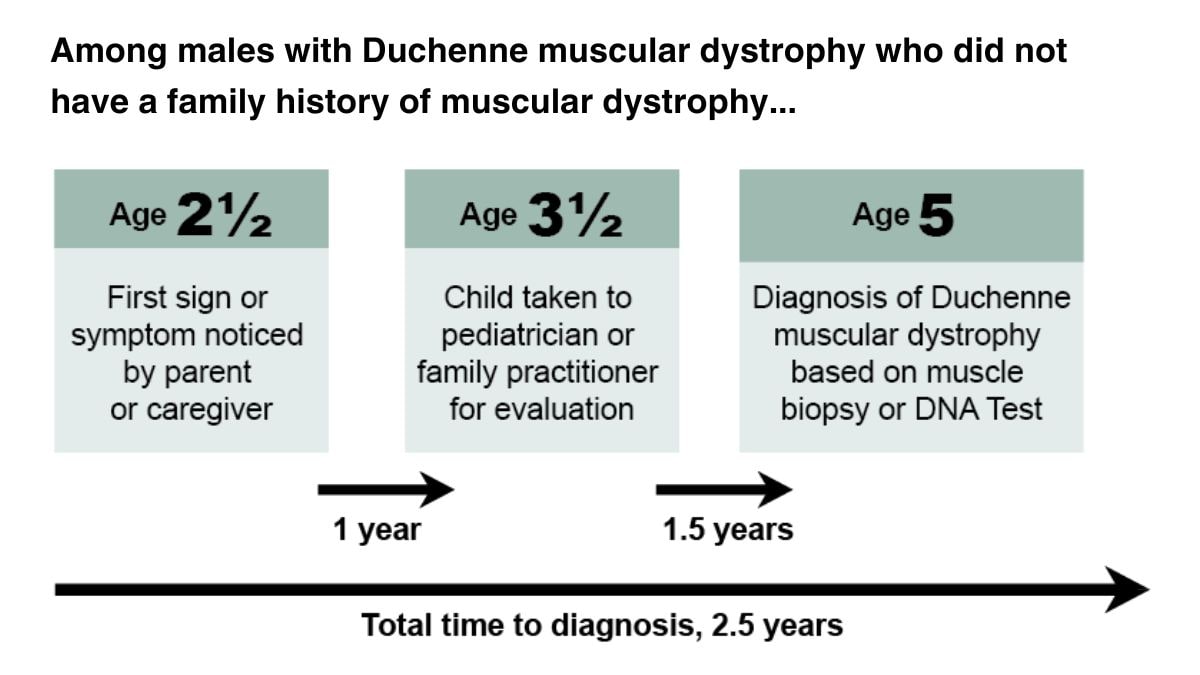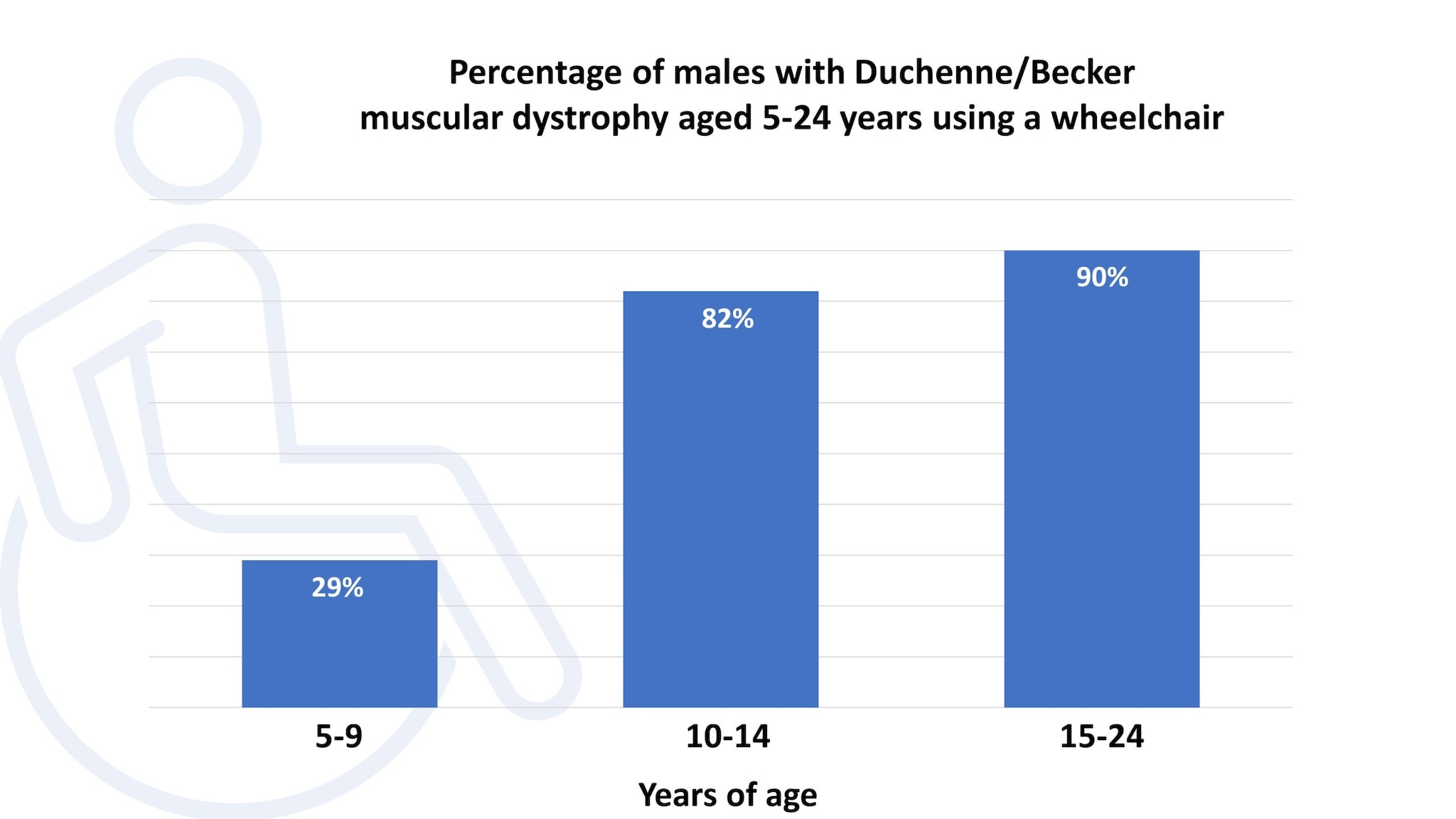Key points
The data and statistics on this page come from MD STARnet. Findings from the MD STARnet sites cannot be generalized to the entire United States.

MD STARnet: How we got these numbers
The tables below show data on males with Duchenne or Becker muscular dystrophy (DBMD) in 10 MD STARnet states or regions. The information was collected during the years 1982-2015. Incomplete records may cause the totals in each table to differ.
These numbers represent males identified with asymptomatic, definite, or probable DBMD. These criteria are described in detail in Table 1 within the MD STARnet case definitions.
Classifying someone as having DBMD is based on:
- When symptoms first appear
- Genetic testing results
- Muscle biopsy results
- When an individual stopped walking
- Steroid use
Those who could not be classified as having definite or probable DBMD were excluded.
Basic data
Phenotype
n
%
Duchenne
1052
83.8%
Becker
140
11.1%
Unable to Determine
64
5.1%
Number and percentage of Duchenne, Becker, and Unknown phenotypes
Race/ethnicity
n
%
Asian/Hawaiian/Pacific Islander
29
2.3%
Non-Hispanic Black
90
7.2%
Hispanic/Latino
249
19.8%
Non-Hispanic White
752
59.9%
Other*
35
2.8%
Unknown
101
8.0%
Number and percentage of males with DBMD by race/ethnicity
*Native American, American Indian, Alaskan Native, multiple, and other
Insurance type
n
%
Public and Private
211
16.8%
Public
585
46.6%
Private
348
27.7%
Uninsured
36
2.9%
Unknown
76
6.1%
Number and percentage of males with DBMD by insurance type
Key findings
Prevalence of DBMD
- About 1 in every 5,000 males aged 5-9 years1
- Lower among non-Hispanic blacks than non-Hispanic whites 12
- Higher among Hispanics than non-Hispanic whites12
DMD was three times more prevalent than Becker muscular dystrophy (BMD).2
Survival of males with DMD
The median age of survival in males with DMD was 23.7 years.3 Treatments linked to increased survival in males with DMD were:
- Steroids
- Cough assist, and
- Scoliosis surgery.
Diagnosis

Among males with DMD who did not have a family history of muscular dystrophy the:
- Time between noticing signs and diagnosis was about 2.5 years45
- Average age at diagnosis was 5 years45
When compared to non-Hispanic white children, non-Hispanic black or Hispanic children on average:
Steroid use
- The average age when boys began taking steroids was 7 years old.7
- Between about 1/2 and 2/3 of males with DBMD had taken steroids.7
- Black males with DMD began steroid treatment less often.8
Steroid use and walking
On average, males with DMD who:
- Had not taken steroids stopped walking at about age 109
- Took steroids for less than 3 years stopped walking at about age 9½9
- Took steroids more than 5 years stopped walking about age 129
Steroid use and heart and lung problems
Each year of steroid use lowered the chance of heart problems by 4%.7 Males with DMD who continued to use steroids after they stopped walking:
Wheelchair use
The proportion of males with DBMD who used a wheelchair varied by age:
- About 3 in 10 males with DBMD ages 5 to 9 years used a wheelchair.11
- About 8 in 10 males with DBMD ages 10 to 14 years used a wheelchair.11
- 9 in 10 males with DBMD ages 15 to 24 years used a wheelchair.11

Mental health
For males with DBMD:
- More than 4 in 10 had a mental health concern.*12
- Behavioral concerns were twice as common in those who took steroids.12
- Depression affected those not walking 3 times more than those walking.12
*behavioral concerns, depressed mood, or attention-deficit/hyperactivity disorder (ADHD).12
- Zhang Y, Mann JR, James KA, et al. Duchenne and Becker Muscular Dystrophies' Prevalence in MD STARnet Surveillance Sites: An Examination of Racial and Ethnic Differences. Neuroepidemiology. 2021 Mar;55(1):47-55.
- Romitti PA, Zhu Y, Puzhankara S, James KA et al. Prevalence of Duchenne and Becker muscular dystrophies in the United States. Pediatrics. 2015 Mar;135(3):513-21.
- Paramsothy P, Wang Y, Cai B et al. Selected clinical and demographic factors and all-cause mortality among individuals with Duchenne muscular dystrophy in the Muscular Dystrophy Surveillance, Tracking, and Research Network. Neuromuscular Disorders, 2022 Jun;32(6):468-476
- Ciafaloni E, Fox DJ, Pandya S, Westfield CP, Puzhankara S, Romitti PA, Mathews KD, Miller TM, Matthews DJ, Miller LA, Cunniff C, Druschel CM, Moxley RT. Delayed diagnosis in Duchenne muscular dystrophy: data from the Muscular Dystrophy Surveillance, Tracking, and Research Network (MD STARnet).J Pediatr. 2009 Sept;155(3):380-5.
- Thomas S, Conway KM, Fapo O et al. Time to diagnosis of Duchenne muscular dystrophy remains unchanged: Findings from the Muscular Dystrophy Surveillance, Tracking, and Research Network, 2000-2015. Muscle Nerve. 2022 Mar;66(2):193-197.
- Holtzer C, Meany FJ, Andrews J et al. Disparities in the diagnostic process of Duchenne and Becker muscular dystrophy. Genet Med. 2011 Nov;13(11):942-947.
- Barber BJ, Andrews JG, Lu Z, West NA, Meaney FJ, Price ET, Gray A, Sheehan DW, Pandya S, Yang M, Cunniff C. Oral corticosteroids and onset of cardiomyopathy in Duchenne muscular dystrophy. J Pediatr. 2013 Oct;163(4):1080-4.e1.
- Fox DJ, Kumar A, West N, DiRienzo AG, James KA, Oleszek J; Muscular Dystrophy Surveillance, Tracking, and Research Network (MD STARnet). Trends with corticosteroid use in males with Duchenne muscular dystrophy born 1982-2001. J Child Neurol. 2015 Jan;30(1):21-6.
- Kim S, Campbell KA, Fox DJ, Matthews DJ, Valdez R; MD STARnet. Corticosteroid treatments in males with Duchenne muscular dystrophy: Treatment duration and time to loss of ambulation. J Child Neurol. 2015 Sept;30(10):1275-80.
- Butterfield RJ, Kirkov S, Conway KM, et al. Evaluation of effects of continued corticosteroid treatment on cardiac and pulmonary function in non-ambulatory males with Duchenne muscular dystrophy from MD STARnet. Muscle Nerve. 2022 Jul;66(1):15-23.
- Centers for Disease Control and Prevention (CDC). Prevalence of Duchenne/Becker muscular dystrophy among males aged 5-24 years – four states, 2007. MMWR Morb Mortal Wkly Rep. 2009 Oct 16;58(40):1119-22
- Caspers Conway K, Mathews KD, Paramsothy P, Oleszek J, Trout C, Zhang Y, Romitti PA; MD STARnet. Neurobehavioral concerns among males with dystrophinopathy using population-based surveillance data from the Muscular Dystrophy Surveillance, Tracking, and Research Network.external icon J Dev Behav Pediatr. 2015 Jul-Aug;36(6):455-63.
